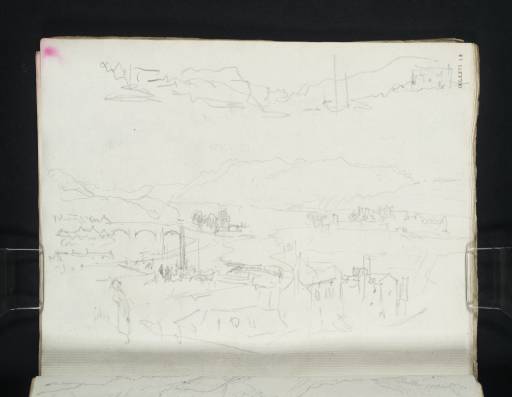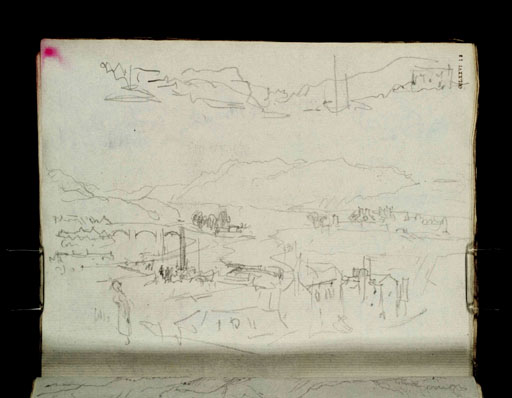J.M.W. Turner
>
1830-35 Annual tourist
>
Scotland 1831
>
Fort Augustus Sketchbook
>
Artwork
Joseph Mallord William Turner Fort Augustus 1831
Image 1 of 2
Joseph Mallord William Turner,
Fort Augustus
1831
Joseph Mallord William Turner 1775–1851
Folio 18 Recto:
Fort Augustus 1831
D26996
Turner Bequest CCLXXVI 18
Turner Bequest CCLXXVI 18
Pencil on off-white laid writing paper, 150 x 180 mm irregular
Inscribed in red ink by John Ruskin ?‘18’ top left running vertically
Stamped in black ‘CCLXXVI 18’ top right running vertically
Inscribed in red ink by John Ruskin ?‘18’ top left running vertically
Stamped in black ‘CCLXXVI 18’ top right running vertically
Accepted by the nation as part of the Turner Bequest 1856
References
1909
A.J. Finberg, A Complete Inventory of the Drawings of the Turner Bequest, London 1909, vol.II, p.881, CCLXXVI 18, as ‘Fort Augustus. See Engraving, Scott’s Prose Works, 1836.’.
This sketch of Fort Augustus became the basis of Turner’s watercolour, Fort Augustus, Loch Ness circa 1833 (private collection),1 engraved as the vignette illustration to volume XXVI of Sir Walter Scott’s Tales of a Grandfather in 1836.2 Although he was principally in Scotland to collect material for Scott’s collected Poetical Works, the abundance of details in this sketch suggests that, whether or not he knew how he would use it at the time, Turner foresaw the potential in this sketch for a finished picture.
The view is north-east over Fort Augustus towards Loch Ness. Looking over the rooftops the sketch must have been made from a high point, probably from one of the more elevated locks which form a short staircase down the Caledonian Canal to Loch Ness. A female figure stands in the foreground at the left, presumably on the canal towpath. Beyond the rooftops is the Caledonian Canal, with a steamboat waiting to go through the final gate before it can head out to Loch Ness. A number of dark figures stand on board or on the towpath.
In the foreground of his watercolour Turner included a steam paddleboat with a group of about two dozen tourists crowding its deck as it prepared to go through the lock to Loch Ness. This detail was autobiographical as Turner arrived in Fort Augustus by steamboat. The guidebook that may have directed him, The Steamboat Companion, advised that ‘During the hour and a half that the steam-boat takes to pass the locks at Fort-Augustus, passengers may land, and may here dine comfortably on shore.’3 Turner used this time to disembark and make a number of sketches of different views of the village, including the one currently under discussion, before boarding again to begin a journey up Loch Ness to Inverness.
To the left of the canal – running parallel to it – is the River Oich, over which spans the three-arched Old Oich Bridge, seen in many of the sketches that Turner made of Fort Augustus. Only the left arch still stands today, as the others were washed away in a flood of 1849 and were later replaced with a wooden structure. The remains of the fort stand between the canal and the River Tarff to the east (see folio 13; D26986). Beyond the town is Loch Ness.
At the top of the page is a sketch of hills and two vertical lines which probably represent the masts of a boat. A curved line at the centre probably represents the left bank of a river, making this a view south down the canal from the same spot.
Further sketches of Fort Augustus are on folios 13 and 15 verso–18 verso (D26986, D26991–D26997).
Thomas Ardill
April 2010
How to cite
Thomas Ardill, ‘Fort Augustus 1831 by Joseph Mallord William Turner’, catalogue entry, April 2010, in David Blayney Brown (ed.), J.M.W. Turner: Sketchbooks, Drawings and Watercolours, Tate Research Publication, December 2012, https://www


